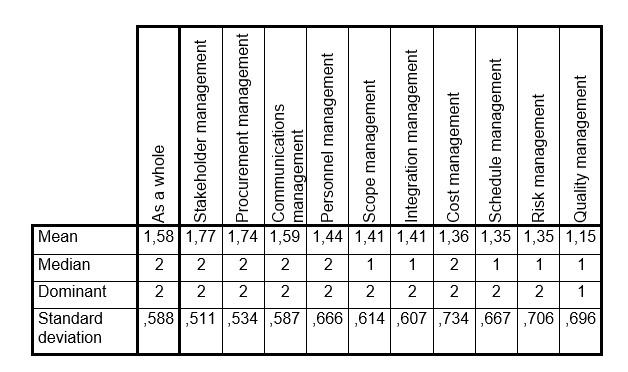Part 2
Let’s talk about public projects!
SERIES ARTICLE
By Stanisław Gasik
Warsaw, Poland
Introduction
Today, as in the previous article in the Let’s talk about public projects series (Gasik, 2024), we will look at the relative complexity of public projects compared to projects in other sectors. The analysis is based on the results of a survey (Gasik, 2023a). In this survey each participant could assess the relative complexity of public projects using a scale ranging from 0 (private projects being more complex than public projects) to 1 (no discernible differences in complexity) to 2 (public projects being more complex). The survey findings are presented in Table 1 below.
In a previous article, we looked at stakeholder management, procurement management and communications management. Today we will look at the differences in other areas of project management[1].
Table 1. The Relative Complexity of Public Sector Project Management Areas (source Gasik, 2023a)

Personnel Management
Possession of an organization by the government significantly affects the processes of personnel management (Rainey and Bozeman, 2000) as well as the behavior of project team members.
Numerous studies report lesser work involvement of public-sector workers than those of other sectors (e.g., Subramanian and Kruthika, 2012; Rainey, 2014). At the same time, the protection system of civil servants and employment results in limited opportunities for creating and modifying project teams (Wirick, 2009).
Workers in different sectors differ in their vulnerability to different types of motivation. In the public sector, the factors most motivating staff to work are stable, secure future, a chance to learn something new, and the opportunity to use special abilities (Jurkiewicz et al., 1998), the importance of public services, participating in the implementation of public policies, sacrifice for others, responsibility and integrity (Rainey and Bozeman, 2000). Public-sector employees are less vulnerable to external stimuli including financial incentives (e.g., Buelens and Van den Broeck, 2007; Jałocha et al., 2014; Rainey, 2014). In the private sector, the prime motivating factors are high salary, the chance of being a leader, and promotion (Jurkiewicz et al., ibid). Hence, motivation systems in the public sector should be aimed at internal rather than external incentives. When recruiting team members for public projects, their significance for the community of beneficiaries should be emphasized and material incentives to a lower extent.
More…
To read entire article, click here
Editor’s note: This article series is related to the management of public programs and projects, those organized, financed and managed by governments and public officials. The author, Dr. Stanisław Gasik, is the author of the book “Projects, Government, and Public Policy”, recently published by CRC Press / Taylor and Francis Group. That book and these articles are based on Dr. Gasik’s research into governmental project management around the world over the last decade. Stanisław is well-known and respected by PMWJ editors; we welcome and support his efforts to share knowledge that can help governments worldwide achieve their most important initiatives.
How to cite this paper: Gasik, S. (2024). How public projects differ from other projects, Part 2, Let’s talk about public projects, series article, PM World Journal, Volume XIII, Issue V, May. Available online at https://pmworldlibrary.net/wp-content/uploads/2024/05/pmwj141-May2024-Gasik-How-Public-Projects-Differ-Part-2.pdf
About the Author

Stanisław Gasik, PhD, PMP
Warsaw, Poland
![]()
Dr. Stanisław Gasik, PMP is a project management expert. He graduated from the University of Warsaw, Poland, with M. Sc. in mathematics and Ph. D. in organization sciences (with a specialty in project management). Stanisław has over 30 years of experience in project management, consulting, teaching, and implementing PM organizational solutions. His professional and research interests include project knowledge management, portfolio management, and project management maturity. He is the author of the only holistic model of project knowledge management spanning from the individual to the global level.
Since 2013, his main professional focus has been on public projects. He was an expert in project management at the Governmental Accountability Office, an institution of the US Congress. He is the author of “Projects, Government, and Public Policy,” a book that systematizes knowledge about government activities in the area of project management.
He was a significant contributor to PMI’s PMBOK® Guide and PMI Standard for Program Management and contributed to other PMI standards. He has lectured at global PMI and IPMA congresses and other international conferences.
His web page is www.gpm3.eu.
To view other works by Dr. Gasik, please visit his author showcase in the PM World Library at https://pmworldlibrary.net/authors/stanislaw-gasik-phd-pmp/
[1] This article is based on the content of chapter, Differences between Public Projects and Projects of Other Sectors” (Gasik, 2023a).









